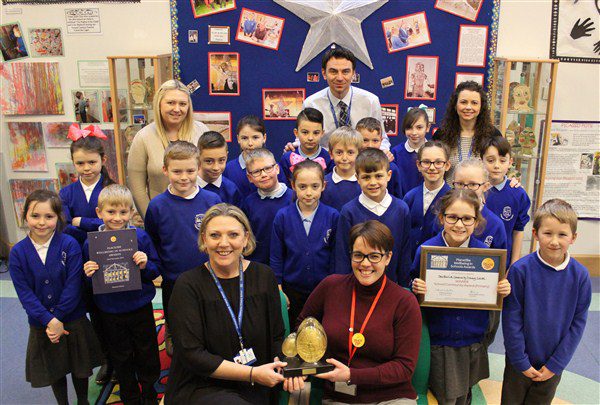The theme for British Science week this year was connections. We completed this with a forensics themed week. We had to connect as a school to solve a crime – Who stole the globe? Each year group had to complete a different investigation linked to a crime scene and then we came together in assembly at the end of the week to decide who we thought was the culprit. Our local community police officers even came in to see how we had been doing! Take a look at all of the amazing work we have completed in our year groups.
EYFS
The nursery staff explained what has happened to the golden globe and we spoke about who we thought might be the culprit. We had a range of white powders that we needed to test. We had these powder in a tray and needed to add water to these to see which powder reacted. We had lots of fun experimenting and found that the canderel powder reacted the most. We think Miss Brooke stole the golden globe!


Year 1
Year 1 were so excited by Forensic Science week. We were ‘hooked’ into our topic through an investigation of drink tasting. We were blind folded and had to guess the drink we were drinking. We made amazing guesses through the use of our taste senses and previous experiences. We then worked in a carousel to investigate a range of stations. We had to guess what was in the boxes, using touch. We investigated fruits through magnifying glasses.
We couldn’t wait to be real investigators to figure out who stole the Globe. We listened to all of the witness statements and used these to discuss who we thought it was. We were adamant it was Mr Robson. Measuring the suspects footprints was extremely fascinating. We were over the moon when we worked in teams to work out that we thought it was Mrs Beresford as her footprint was the same size as the one at the crime scene.

Year 2
For science week, Year 2 have been analysing notes that all had different handwriting. We used our investigation skills to compare what was the same and what was different between the handwriting evidence and the suspect’s handwriting in order to conclude who committed the crime of stealing the globe.

Year 3
In year 3, we had lots of fun investigating who stole the globe. We used hair fibres from the scene to assist us with our investigation by forensically analysing and comparing the hair samples.
We narrowed the 5 suspects down to Mrs Stephenson and Miss Dickinson by looking closely at the hair fibres using a magnifying glass. We discovered that Mrs Stephenson’s hair matched the hair at the crime scene because her hair was exactly the same colour and thickness.

Year 4
We have been investigating finger prints to find out who stole the school globe.
We have learned how to take our own finger prints today. We know that there are 3 types of finger print; arch, whorl and loop. Everyone’s finger prints are different so if there was a crime scene, the police would know exactly who committed the crime.
We have found that forensics are important because they can’t lie! Before our finger print investigation, we predicted who stole the globe and then repeated this after the investigation. We totally changed our minds.



Year 5
In year 5, we looked at the soil on the shoes of the suspects. We tested the soils for acidity using universal indicator paper. When you put universal indicator paper into a solution it will turn a certain colour based on the acidity of the soil. One piece of indicator paper went a dark red colour showing that the soil sample was very acidic. We then tested the soil from the crime scene and the indicator paper also turned dark red. We concluded that the culprit was Mrs Beresford as the soil from her shoe matched the soil from the crime scene.
Year 6
In year 6, we investigated ink using chromatography to try and work out which of the 5 suspects stole the globe…
Chromatography is a method used to separate mixtures. Chromatography is used for all sorts of purposes – checking that our food and our medicines don’t contain dangerous impurities, testing athletes to ensure they aren’t taking any performance-enhancing drugs, and testing our water supply to check that it is not polluted. Police forensic scientists really do use chromatography to identify substances found at crime scenes.
All of the 5 teachers (suspects) were asked to hand over their most used pen. The pens were different, but when we tried them out the writing all looked very similar. So, we used a scientific technique called chromatography to analyse the ink in the note that was found at the crime scene to find out which pen had written it.
Method
1. We cut a strip off the left edge of the note found at the crime scene (with the O on it) and drew matching O’s from all of the five ‘suspect’ pens on another piece of filter paper, labelled with the suspect’s initials.
2. We pegged the piece of the note found at the crime scene next to the test paper, above a tray of water so that the bottom edges of the papers were just touching the water. We waited as the water moved up the paper and watched what happened.
3. After a few minutes, we dried the papers off and compared the ink patterns.
Conclusion
After we dried the papers off and compared the ink patterns, we found that the five inks were actually very different. Our findings showed that Mr Scott’s pen wrote the note.



Overall conclusion…
After we all used our amazing forensic scientific skills we discovered that it was Mrs Beresford who stole the globe! Luckily, she was just having a joke and brought the globe straight back into school.





Comments are closed.